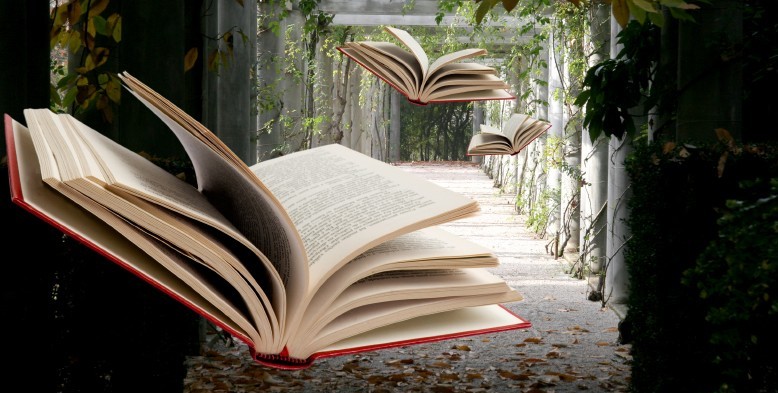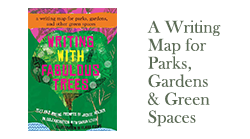Trees
Friday, December 21st, 2012
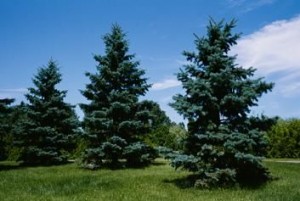 I’m reading a new book on my Kindle by Jean Shinoda Bolen, MD entitled Just Like A Tree: How Trees, Women and Tree People Can Save The Planet (2011) Conari Press. I love discovering new books about trees, as there is always some new information about trees that I didn’t know about before that I come across.
I’m reading a new book on my Kindle by Jean Shinoda Bolen, MD entitled Just Like A Tree: How Trees, Women and Tree People Can Save The Planet (2011) Conari Press. I love discovering new books about trees, as there is always some new information about trees that I didn’t know about before that I come across.
I wasn’t disappointed with this book, although it was a challenge to read in places, as there is much in the reference materials that I’ve already used in the book I’m currently writing about trees.
One piece of new information I came across was about Conifers and Evergreens trees, which the humble Christmas tree belongs to. I find it so easy to not even imagine the Christmas tree, which has been colonized for our homes even, grew in real forests and endured survival in harsh soils and conditions, but apparently this is very much the case. After reading about the physiology of this family of trees I don’t think I can ever look upon a real Christmas or Evergreen trees in the same way now that I know what it has come through.
Below are two short excerpts form Jean’s book minus the page reference (as I’m reading it on my Kindle). I hope it will enlighten you about the hardy Christmas tree and what tress from this lineage have endured to find it’s way into your home and living room this Christmas.
“ Those with the oldest lineage are members of the conifer family. The conifers do nothing showy- no autumn colours, spring blossoms, or glorious fruit – but when they are noticed and we understand how wonderful they are, a depth and poetic appreciation can result. Out of their wonder and love of the trees they study, naturalists have written about them with poetic sensibility. John Muir, America’s most famous and influential naturalist, for example, described a juniper as “a sturdy storm-enduring mountaineer of a tree, living on sunshine and snow, maintaining tough health on his diet for perhaps more than a thousand years” (Muir, My first Summer in the Sierra, 1911. P.146).
“ The Conifers are the trees I have most bonded with, and there is a geographic affinity between California and the North American boreal confer forests that draws me to their plight. How many Pine trees are cut down is a market supply and demand decision.
This is the one time of the year billions of people bring trees intentionally into their home. Find a way of really connecting with your tree. Use your fingertips to touch the pine needles, put your nose close. Is there still a trace of the scent of its natural fragrance?
Enjoy your Christmas tree this Christmas and as the new year arrive rather than leave it for the recycling collection try replanting this tardy tree in your garden or in an open space and see how it fares throughout the year.
No Comments
Friday, December 7th, 2012
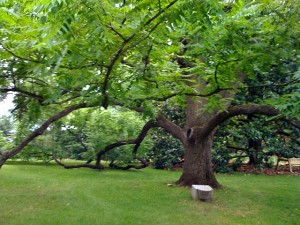 Photo credit David Burn
Photo credit David Burn
The Black Walnut Tree
My mother and I debate:
we could sell
the black walnut tree
to the lumberman,
and pay off the mortgage.
Likely some storm anyway
will churn down its dark boughs,
smashing the house. We Talk
slowly, two women trying
in a difficult time to be wise.
Roots in the cellar drains,
I say, and she replies
that the leaves are getting heavier
every year, and the fruit
harder to gather away.
But something brighter than money
moves in our blood-an edge
sharp and quick as a trowel
that wants us to dig and sow.
So we talk, but we don’t do
anything. That night I dream
of my fathers out of Bohemia
filling the blue fields
of fresh and generous Ohio
with leaves and vines and orchards.
What my mother and I both know
is that we’d crawl with shame
in the emptiness we’d made
in our own and our father’s backyard.
So the black walnut tree
swings through another year
of sun and leaping winds,
of leaves and bounding fruit,
and, month after month, the whip-crack of the mortgage.
- 1992 Mary Oliver
No Comments
Wednesday, December 5th, 2012
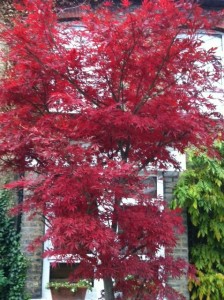
I wrote this blog post three weeks ago and it dawned on me that the red trees have all but disappeared from our landscape. Winter is truly here. So delight in what was.
Three weeks ago on my morning walk to Sainsbury’s to do some shopping I set myself a creative challenge of taking photos of every red tree or leaf I passed on my walk.
Autumn is a wonderful time of the year to observe the shift of colours of the trees from the normal greens to the shimmering tones of red, bronze, copper and maroon’s that burst onto the branches of many trees and take centre stage. Meditate on the colours.
Grab a camera or your phone camera and embark on a colour of the trees walk and get inspired.
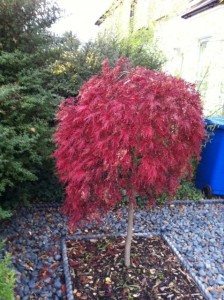
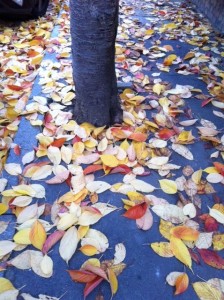
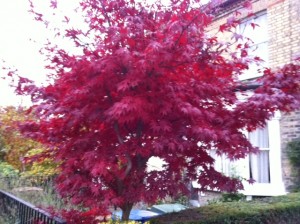
No Comments
Friday, November 30th, 2012
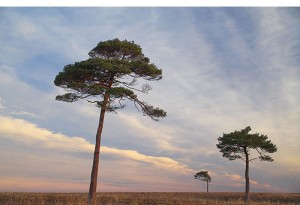
Have you ever noticed how many trees resemble human beings? Really, take a good look at the shapes and faces of trees as you manoeuvre through your day and see how many resemble the people you know, love or work with. We can use poetry in the same way as we do writing prompts. Poems help us to unravel ourselves on the page and you can use a poem to warm up on the page or to kick start your writing practice.
Poems can be a great tool for reflective inquiry into the self when you’re not sure where to start. They are a great way to contain emotions when writing about difficult or complex emotions or events. I remembered a poem that we examined on my Masters in creative writing and personal development. It was by the Scottish poet Jackie Kay:
My grandmother is like a Scottish pine
tall, straight backed, proud and plentiful
a fine head of hair, greying now
Tied up in a loose bun.
Her face is ploughed land
Her eyes shine rough as amethysts.
She wears a plaid shawl with the zeal of an Amazon
She is one of those women
burnt in her croft rather than moved off her land
She speaks Gaelic mostly,
English only
when she has to, then its blasphemy.
My grandmother sits by the fire and swears
“There’ll be no darkie baby in this house”
My grandmother is a Scottish pine
Tall, straight-backed, proud and plentiful
Her head tied with pins in a ball of steel wool
Her face is high as ice
And her eyes are amethysts
- That Distant Apart, 1991 Turret Books
The poem evoked ambivalent memories of my own difficult relationship with my paternal grandmother. Memories I have conveniently chosen not to dwell on. I was five years old when she came from the Caribbean to join the family in the UK. She was cold, cruel and nasty to me for the two years that she stayed with us. I remember her stay as a very bleak time.
After reading the poem for this blog I took to the page to record my memories of grandmother and me and in my writing I recalled some stark memories of her. The lines on her face from where she always frowned remind me of the lines on tree bark. I remembered a transparent bag she carried which intrigued my childhood curiosity. Her shape was less the slender frame of a pine tree and more suited to that of a beech or an oak. The poem provided a ‘safe enough’ space for me to explore grandmother and me.
But there was plenty more to explore about the poem. I enjoyed the way Kay uses images and metaphors of the earth. I particularly line her opening line as I imagined her grandmother’s height and frame captured in the image of the pine tree. Kay caught me by surprise as I typed out the poem when I realised her sentiments about her grandmother changed halfway through.
The steadiness of the image of the Scottish pine tree at the start and the close of the poem allow me to navigate my way through the shadow side Kay presents of her grandmother. There is space to hold the line. “There’ll be no darkie baby in this house, “ and all that this explicit line suggests. I am left with the upfront image of the grandmother’s shadow side, “her head tied with pins in a ball of steel wool.” My Dad was a carpenter and I knew the feel and coarse texture of steel wool that would slice your fingers open with the barest amount of pressure to the skin.
Poetic Inquiry:
1. What are your personal views about the poem?
2. What was your relationship like with any of your grandparents or great grandparents if you knew them? Write about your memories.
3. What are your personal stories of racism or of being ostracised or excluded growing up either as a receiver or as an observer?
4. Whose faces and stature do you see in the trees around you?
No Comments
Thursday, November 29th, 2012
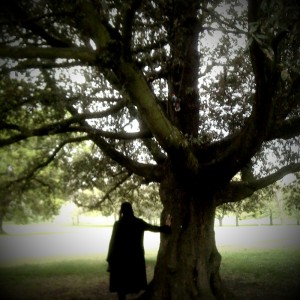
This is me standing with one of my favourite Oak trees, Sanctuary. On many occasions she has been my refuge. The quote below is by Karen Salmansohn and speaks to the strength of the Oak tree.
“Again let’s consider the mighty Oak tree. When a storm hits it, the mighty Oak is meant to grow into an even mightier Oak – that is if the mighty Oak intuitively bends to endure these stormy winds and thereby grows stronger trunks and branches. Yep – the storm is actually in the long run the best thing to happen to a mighty oak because it helps the mighty Oak to grow into its highest, possible, mightiest potential.”
Karen Salmansohn blog post 2nd November 2012 http://notsalmon.com
Photo credit: Robin Rezende
No Comments
Monday, November 26th, 2012
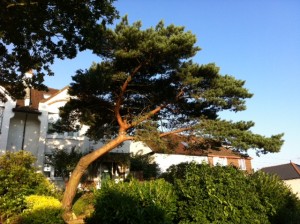
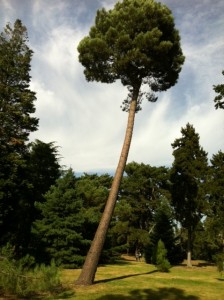
All photo’s Jackee Holder 2012
I love taking photos of solitary or almost solitary trees. This first shot is of a tree a couple of streets away from where I live (although not entirely alone I like the way the tree holds its own spot. The second image which I just love is of a tree I came across in one of my favourite green spaces in London, Kew Gardens. This tree has definitely carved out a spot all of its own.
I have a stunning book of tree images, Trees edited by Lisa Purcell each image accompanied by a tree quote. Here are a couple of the quotes about solitary trees:
” Earth teach me the courage of the tree that stands all alone.” – William Alexander
” Trees are much like human beings and enjoy each other’s company. Only a few love to be alone.”
As you go about your week notice the trees that stand alone. What do you notice about the trees aura and presence that may be different from when trees are grouped together?
How about taking a few snapshots of solitary trees you come across?
No Comments
Friday, November 23rd, 2012
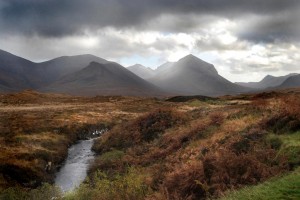
The Peace Of Wild Things
When despair for the world grows in me
and I wake in the night at the least sound
in fear of what my life and my children’s lives may be,
I go and lie down where the wood drake
rests in his beauty on the water, and the great heron feeds.
I come into the peace of wild things
who do not tax their lives with
forethought
of grief.
I come into the presence of still water.
And I feel above me the day-blind stars
waiting with their light. For a time
I rest in the grace of the world, and am free.
- Wendell Berry from Collected Poems
Poetic Inquiry
1. What nature spots or wild places bring you alive?
2. Write about one of those places describing it in every detail to someone who was blind. Write descriptively and about how the place makes you feel.
3. Schedule in a date with nature
No Comments
Friday, November 23rd, 2012
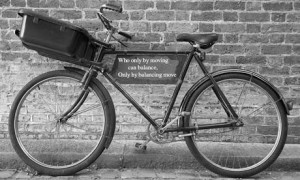 Photograph Winning Words www.winningwordspoetry.com
Photograph Winning Words www.winningwordspoetry.com
Every Friday to kick start your weekend we’ll post a poem on one or all three of the blogs.
There’s a poem for every ailment. We can write our own poems to distill our experiences or feelings or we can use the medicine and wisdom from other people’s poems to understand ourselves, and our worlds better. In the poetry world this technique is known as a poetry prescription. When I read other people’s poems they help me to better articulate and feel my emotions. I find myself in a relationship with the poet and a realization that I am not alone with what I experience on a day-to-day basis. Have you noticed how some poets find just the right words to describe particular events and life experiences from the large to the small?
More and more I’m noticing how poems stop me in my track. Causing me to pause and allow the words to sink in a more conscious and mindful manner. I like that about poetry. Reading poetry and engaging with a poem is an act of mindfulness, which brings health and emotional benefits to the reader.
Phyllis Klein and Perie Longo writing in an article, The Therapeutic Benefits of Poetry (2006) describes how a poem makes us feel safe because, “a poem has a border, a frame, or structure, as opposed to prose, the form itself is a safety net. Strong emotions will not run off the page.”
Lately I’ve been more courageous in writing poems of my own. When I do I am surprised by how accurately the poem both captures and mirrors my emotions and raw feelings.
Here at www.jackeeholder.com we’re experimenting with Poetic Inquiry. At the end of each poem you‘ll find a list of prompts should you wish to delve more deeply into the poem and explore its meaning and how the poem relates to you. When poetry therapists work with groups and individuals they’ll ask the group which lines resonate with them or what themes they’re drawn to. We hope the prompts offer you some of that exploration if you wish to reflect further. We’d love to know which poems speak to you or even post one of your poems as one of our Friday Poetry Prescription blogs.
No Comments
Wednesday, November 21st, 2012
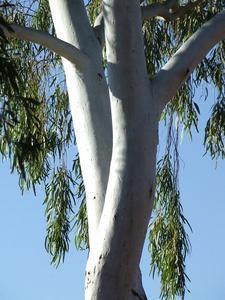
How many times have we walked past a tree and not really taken the tree in? I am flanked on both sides by two Eucalyptus trees in the neighbouring gardens to my left and my right which if I’m honest I’ve paid very little attention to.
A chance remark by a guest who was delighted to see the trees, which can’t be missed from our patio called me to pay more attention to this beautiful tree. For my guest it evoked memories of home to see the trees, which are native to their place of birth in Australia. I was a bit disappointed that I hadn’t paid much attention to either of these trees, which tower above the other trees in the area.When I really discovered the tree she was in full blossom. A blossom easily, camouflaged by the faint pale white colour of the flowers that remained almost hidden amongst the mint coloured green leaves.
Normally I flirt with trees with thick, solid trunks and who are likely to have been alive for over a hundred years. The Eucalyptus tree, slim and yielding with a charcoal grey bark seems young and sober in comparison and less inviting that the types of trees I am normally captivated by.But from the moment of the Eucalyptus’s identity I began imagining Koala bears clambering up her trunk with babies on their back. Once a year the bark is shed in huge slabs and displays new colours, ranging from pale cream to light orange. Once the new bark is worn in the colour fades to a light grey, and then weathers a little more until the medium grey is back for the rest of the year. There’s always more to the trees we look at on a regular basis.
Most days the Eucalyptus is the first tree my eyes fall on when I sit down at my desk and turn to look outside my office window. I can tell the weather by the shape and formation one of these trees makes as it bows to the force of the wind or whether she is standing tall and straight indicating that this will be a day of little wind, but will be calm. I love the way the leaves of the tree shakes and shimmering in the breeze looking like fists waving energetic hellos.
I never tire looking at the Eucalyptus tree now and am glad that I have really connected with her.
No Comments
Tuesday, November 20th, 2012
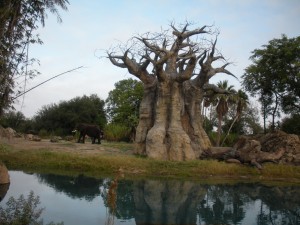
©tracyantonioli used with permission
“When you look at a tree, you see a source of wood, perhaps shelter. You see a thing of strength and beauty. If you open your mind, you may see a chair, a table, even the frame of a sofa. Your physical senses coupled with imagination give you the ability to see what a thing can become. Yet there is so much you cannot see. You cannot see the age of the tree, how deep its roots grow, the number of people who have sat at the foot of the tree to picnic or cry. You do not know how many animals, insects, or people have eaten from the fruit of the tree, or have survived a storm because of the position of that tree. The tree may have medicinal or sentimental value you cannot see. Rest assured, the tree has a value, purpose and meaning beyond all that you can see or imagine.”
When faced with a difficult situation, a challenge in life, you do not always see the intangible value and worth of the experience.
- Iyanla Vanzant, The Spirit Of A Man
What have been the gifts from your difficult and tough life and work challenges?
By the way how real does that tree look to you? Just like our thoughts not everything we think or see is as it is.
No Comments
 I’m reading a new book on my Kindle by Jean Shinoda Bolen, MD entitled Just Like A Tree: How Trees, Women and Tree People Can Save The Planet (2011) Conari Press. I love discovering new books about trees, as there is always some new information about trees that I didn’t know about before that I come across.
I’m reading a new book on my Kindle by Jean Shinoda Bolen, MD entitled Just Like A Tree: How Trees, Women and Tree People Can Save The Planet (2011) Conari Press. I love discovering new books about trees, as there is always some new information about trees that I didn’t know about before that I come across.
